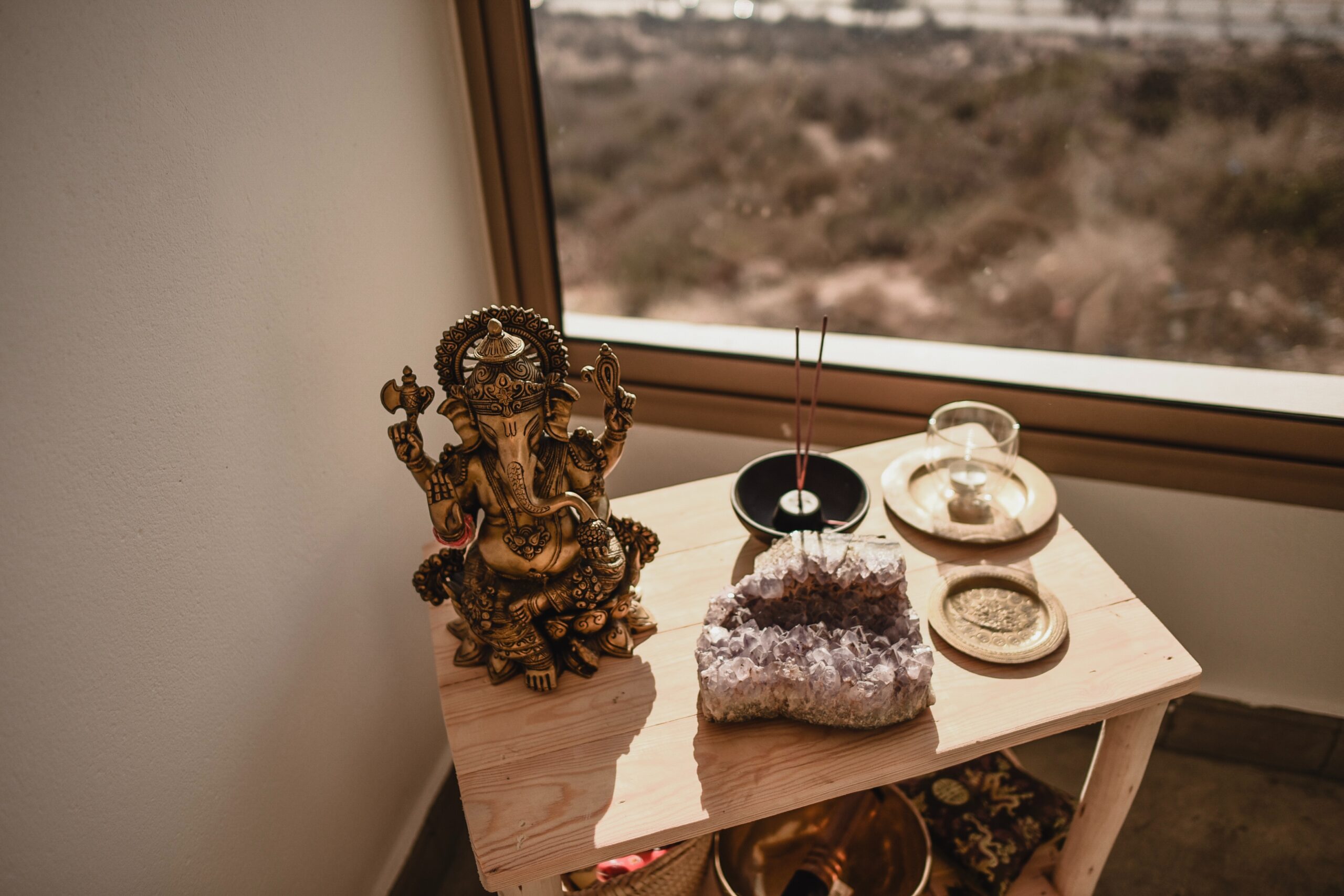Agarbatti
Agarbatti, also known as incense sticks, are thin sticks made from a mixture of aromatic compounds, natural resins, and essential oils. They are typically used for the purpose of creating a pleasant and calming atmosphere in a room or space.
The word “agarbatti” comes from the Sanskrit word “agar,” meaning “perfume,” and “batti,” meaning “stick.” Agarbattis have been used in India and other parts of Asia for centuries, and they are now popular in many other parts of the world as well.
Agarbattis are typically burned in a special holder called an agarbatti stand or incense burner. The stick is lit at one end and allowed to burn slowly, releasing the fragrant smoke into the air. Some people prefer to burn agarbattis for their aesthetic appeal, while others use them for their spiritual or meditative properties.
There are a few precautions to keep in mind when using agarbattis. It is important to keep them out of reach of children and pets, as they can be a choking hazard. It is also important to use caution when lighting agarbattis, as they can cause fires if not handled properly.
Agarbatti raw materials
- Bamboo sticks: Agarbatti sticks are typically made from bamboo, as it is a natural and renewable resource. Bamboo is also strong and flexible, making it an ideal material for incense sticks.
- Powder: Agarbatti powder is made from a mixture of natural ingredients, including essential oils, herbs, and resins. These ingredients are ground into a fine powder and mixed together to create the incense paste.
- Essential oils: Essential oils, such as jasmine, sandalwood, and lavender, are used in agarbatti to add fragrance and aroma to the incense sticks. These oils are extracted from plants and flowers using steam distillation or cold pressing methods.
- Herbs: Herbs, such as basil, rosemary, and sage, are often used in agarbatti for their natural fragrance and aromatherapy properties. These herbs are dried and ground into a fine powder before being mixed into the incense paste.
- Resins: Resins, such as frankincense and myrrh, are used in agarbatti to add a rich, earthy fragrance to the incense sticks. These resins are extracted from trees and plants and are often used in spiritual and religious ceremonies.
- Charcoal: Charcoal is used in agarbatti to help the incense sticks burn evenly and consistently. Charcoal is made from wood or other organic materials that are burned at high temperatures until they turn into a black, porous material.
- Adhesive: An adhesive, such as gum arabic or cornstarch, is used to bind the ingredients together and hold the incense stick shape. This adhesive is mixed into the incense paste to create a sticky, dough-like consistency.

What is Agarbatti used for ? | Benefits of Agarbatti
- Aromatherapy: The fragrance of agarbatti is believed to have calming and relaxing effects on the mind and body, making it an effective tool for aromatherapy.
- Spiritual and religious practices: Agarbatti is commonly used in spiritual and religious practices as a way to honor deities and offer blessings.
- Natural air freshener: Agarbatti can be used as a natural air freshener to add a pleasant fragrance to a room.
- Cover up unwanted odors: Agarbatti can be used to cover up unwanted odors, such as cooking smells or tobacco smoke.
- Eco-friendly: Agarbatti is often made from natural ingredients and does not contain synthetic chemicals, making it a more eco-friendly alternative to synthetic air fresheners.
- Non-toxic: Agarbatti is generally considered to be non-toxic, as it is made from natural ingredients and does not produce harmful emissions when burned.
- Long-lasting fragrance: Agarbatti sticks typically burn for around 30 minutes to an hour, allowing for a long-lasting fragrance in a room.
- Yoga studios and spas : It is used in yoga studios, spas and other such places which are used by people for relaxation and tranquility.
Agarbatti business | How to start Agarbatti business
Starting an agarbatti business can be a lucrative and fulfilling venture. Some steps to consider when starting an agarbatti business include:
- Research the market: It is important to research the market to understand the demand for agarbatti in your area. This will help you determine the type of agarbatti you should produce and the price point you should aim for.
- Choose a location: You will need to choose a location for your agarbatti business, whether it be a physical storefront or an online shop. Consider factors such as accessibility, competition, and your target market when choosing a location.
- Source raw materials: To produce agarbatti, you will need to source raw materials such as bamboo sticks, essential oils, herbs, and resins. Research suppliers and negotiate prices to ensure you are getting the best deal.
- Develop a production process: Determine the most efficient way to produce agarbatti, including mixing ingredients, rolling the paste onto bamboo sticks, and drying the sticks.
- Brand and package your product: Develop a brand and packaging for your agarbatti to help it stand out in the market.
- Market your product: Promote your agarbatti business through various marketing channels, such as social media, website, and local advertising.
- Build relationships with customers: Building relationships with customers is crucial for the success of your agarbatti business. Offer excellent customer service and seek feedback to improve your product and grow your business.

How Agarbatti is made / manufactured ?
- Mixing ingredients: The ingredients for agarbatti, such as essential oils, herbs, and resins, are mixed together in a large container to create a paste.
- Rolling the paste onto bamboo sticks: The paste is then rolled onto bamboo sticks using a machine or by hand.
- Drying the sticks: The sticks are left to dry until the paste hardens and adheres to the bamboo.
- Cutting the sticks: The dried sticks are then cut to a uniform length using a machine or by hand.
- Packaging: The finished incense sticks are packaged in boxes or bags for sale.
- Quality control: The finished agarbatti sticks are checked for quality, including the fragrance and burn time, before being shipped to customers.
Is Agarbatti smoke harmful | Is Agarbatti bad for health
There is some debate about the safety of agarbatti smoke. Some studies have suggested that agarbatti smoke may contain harmful chemicals, such as benzene, formaldehyde, and carbon monoxide. These chemicals have been linked to a variety of health problems, including respiratory issues and cancer.
However, other studies have found that agarbatti smoke contains low levels of harmful chemicals and may not pose a significant risk to human health.
It is important to note that agarbatti made from natural ingredients, such as essential oils and herbs, are likely to have lower levels of harmful chemicals compared to those made with synthetic fragrances.
In conclusion, while more research is needed to determine the potential risks of agarbatti smoke, it is important to use caution and moderation when burning incense sticks. It is also recommended to ensure that the agarbatti you are using is made from natural ingredients and to follow proper ventilation guidelines when burning incense in enclosed spaces.

Famous Agarbatti companies in India
- Nandan Agarbatti Co.
- Mangaldeep Agarbatti
- Zed black Agarbatti
- Shrinivas Sugandhalaya (BNG)
- Moksh Agarbatti
- Cycle Agarbatti
- Hem Agarbatti
- Srinivasa Agarbatti
- Surya Agarbatti
- Satya Agarbatti
- Padmini Agarbatti
- Jyoti Agarbatti
ALSO READ : Food processing industry in India
ALSO READ : Loan/Debt : Benefits & risks










